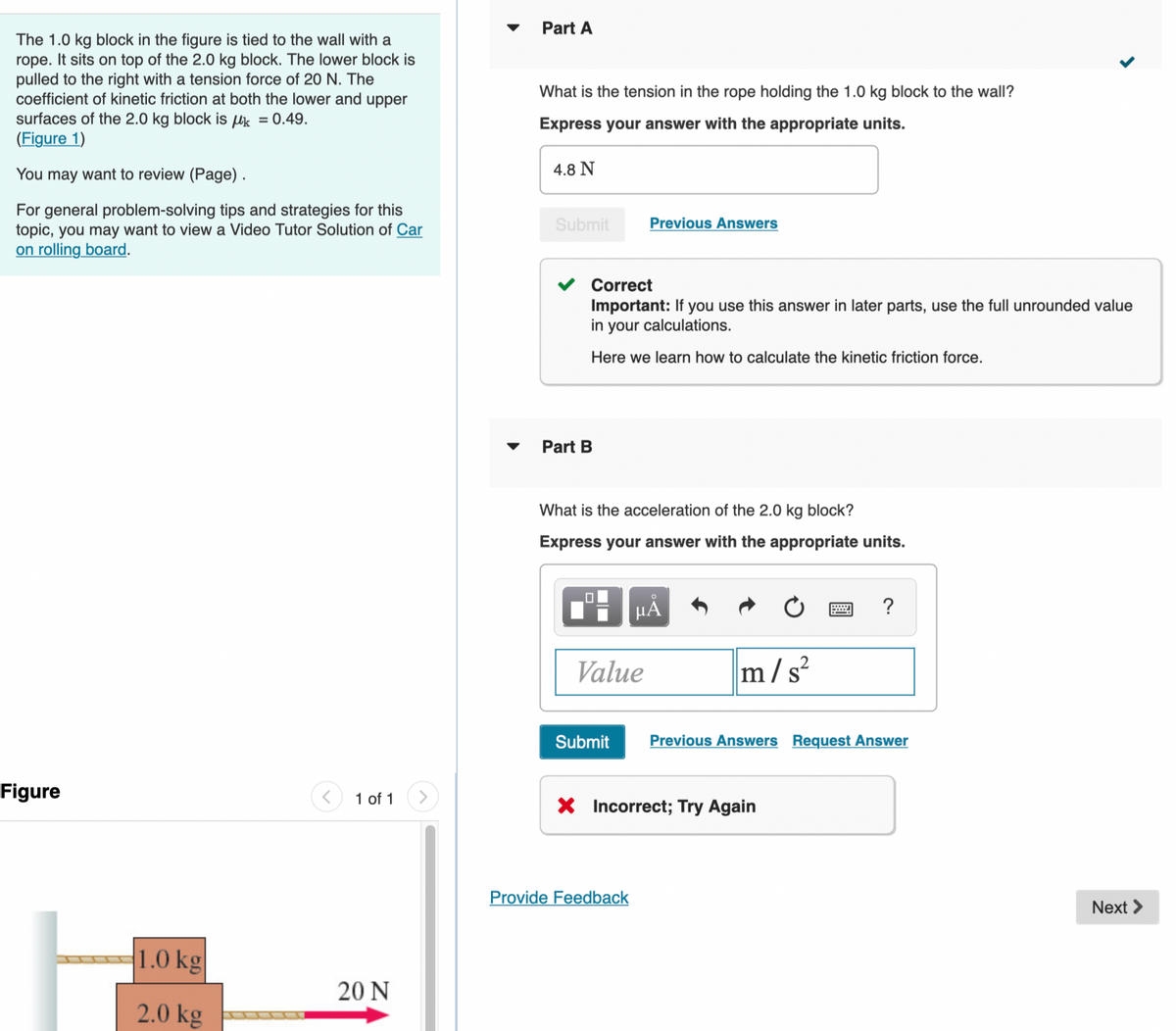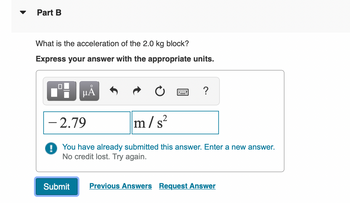The 1.0 kg block in the figure is tied to the wall with a rope. It sits on top of the 2.0 kg block. The lower block is pulled to the right with a tension force of 20 N. The coefficient of kinetic friction at both the lower and upper surfaces of the 2.0 kg block is k = 0.49. (Figure 1) You may want to review (Page). For general problem-solving tips and strategies for this topic, you may want to view a Video Tutor Solution of Car on rolling board. Figure 1.0 kg 2.0 kg 1 of 1 20 N Part A What is the tension in the rope holding the 1.0 kg block to the wall? Express your answer with the appropriate units. 4.8 N Submit Part B Correct Important: If you use this answer in later parts, use the full unrounded value in your calculations. Here we learn how to calculate the kinetic friction force. What is the acceleration of the 2.0 kg block? Express your answer with the appropriate units. 0 Previous Answers Value μĂ Provide Feedback m/s² Submit Previous Answers Request Answer X Incorrect; Try Again ? < Next >
The 1.0 kg block in the figure is tied to the wall with a rope. It sits on top of the 2.0 kg block. The lower block is pulled to the right with a tension force of 20 N. The coefficient of kinetic friction at both the lower and upper surfaces of the 2.0 kg block is k = 0.49. (Figure 1) You may want to review (Page). For general problem-solving tips and strategies for this topic, you may want to view a Video Tutor Solution of Car on rolling board. Figure 1.0 kg 2.0 kg 1 of 1 20 N Part A What is the tension in the rope holding the 1.0 kg block to the wall? Express your answer with the appropriate units. 4.8 N Submit Part B Correct Important: If you use this answer in later parts, use the full unrounded value in your calculations. Here we learn how to calculate the kinetic friction force. What is the acceleration of the 2.0 kg block? Express your answer with the appropriate units. 0 Previous Answers Value μĂ Provide Feedback m/s² Submit Previous Answers Request Answer X Incorrect; Try Again ? < Next >
Principles of Physics: A Calculus-Based Text
5th Edition
ISBN:9781133104261
Author:Raymond A. Serway, John W. Jewett
Publisher:Raymond A. Serway, John W. Jewett
Chapter10: Rotational Motion
Section: Chapter Questions
Problem 80P
Related questions
Question
What is the acceleration of the 2.0 kg block?

Transcribed Image Text:The 1.0 kg block in the figure is tied to the wall with a
rope. It sits on top of the 2.0 kg block. The lower block is
pulled to the right with a tension force of 20 N. The
coefficient of kinetic friction at both the lower and upper
surfaces of the 2.0 kg block is k = 0.49.
(Figure 1)
You may want to review (Page).
For general problem-solving tips and strategies for this
topic, you may want to view a Video Tutor Solution of Car
on rolling board.
Figure
1.0 kg
2.0 kg
1 of 1
20 N
Part A
What is the tension in the rope holding the 1.0 kg block to the wall?
Express your answer with the appropriate units.
4.8 N
Submit
Part B
Correct
Important: If you use this answer in later parts, use the full unrounded value
in your calculations.
Here we learn how to calculate the kinetic friction force.
What is the acceleration of the 2.0 kg block?
Express your answer with the appropriate units.
0
Previous Answers
Value
μĂ
Provide Feedback
m/s²
Submit Previous Answers Request Answer
X Incorrect; Try Again
?
<
Next >
Expert Solution
This question has been solved!
Explore an expertly crafted, step-by-step solution for a thorough understanding of key concepts.
This is a popular solution!
Trending now
This is a popular solution!
Step by step
Solved in 4 steps with 2 images

Follow-up Questions
Read through expert solutions to related follow-up questions below.
Follow-up Question
This is wrong. Fix it immediately. I dont like wasting my questions please.

Transcribed Image Text:Part B
What is the acceleration of the 2.0 kg block?
Express your answer with the appropriate units.
0
O
μᾶ
Submit
?
- 2.79
m/s²
! You have already submitted this answer. Enter a new answer.
No credit lost. Try again.
Previous Answers Request Answer
Solution
Knowledge Booster
Learn more about
Need a deep-dive on the concept behind this application? Look no further. Learn more about this topic, physics and related others by exploring similar questions and additional content below.Recommended textbooks for you

Principles of Physics: A Calculus-Based Text
Physics
ISBN:
9781133104261
Author:
Raymond A. Serway, John W. Jewett
Publisher:
Cengage Learning

Physics for Scientists and Engineers: Foundations…
Physics
ISBN:
9781133939146
Author:
Katz, Debora M.
Publisher:
Cengage Learning

Principles of Physics: A Calculus-Based Text
Physics
ISBN:
9781133104261
Author:
Raymond A. Serway, John W. Jewett
Publisher:
Cengage Learning

Physics for Scientists and Engineers: Foundations…
Physics
ISBN:
9781133939146
Author:
Katz, Debora M.
Publisher:
Cengage Learning